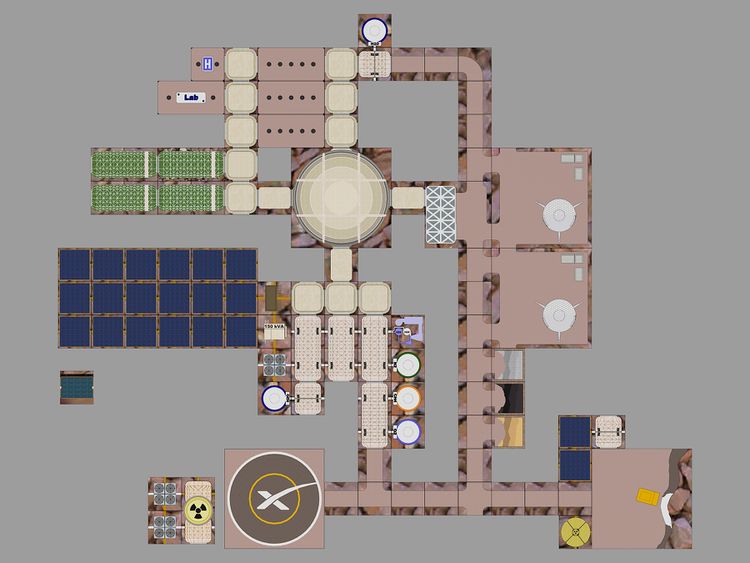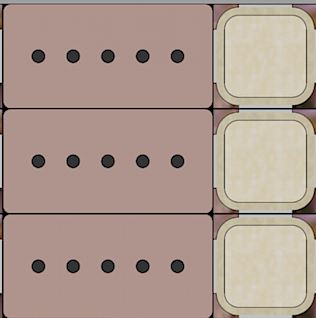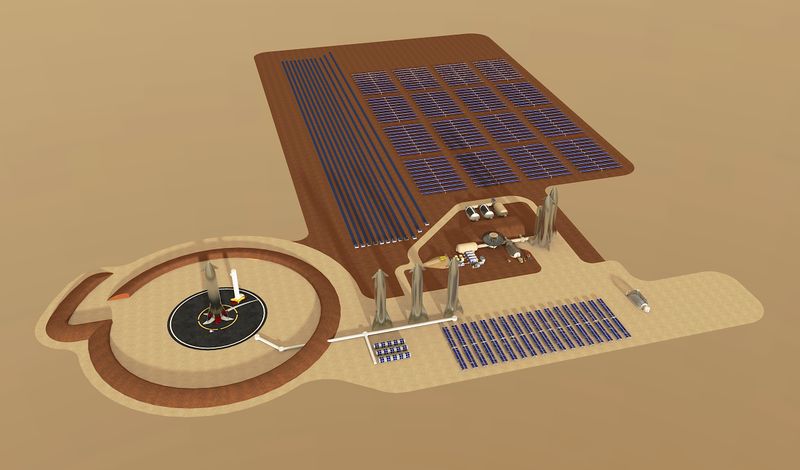Difference between revisions of "Create a settlement"
| Line 38: | Line 38: | ||
===Lodging and offices=== | ===Lodging and offices=== | ||
| − | [[File:Housing tile.JPG|left|link= | + | [[File:Housing tile.JPG|left|link=Housing]] |
===Infirmary=== | ===Infirmary=== | ||
Revision as of 18:32, 23 March 2020
This page shows a typical early settlement for about 25-30 people and includes links to Marspedia pages about the various settlement facilities and their characteristics. If you want to design your own Mars facility, this is a good place to start! The tiles used to build this image of a settlement measure 9m x 9m and are mostly to scale.
Facilities
Storage
At the top of the settlement plan you find a water storage tank, that feeds a water treatment facility. Storage is also provides for other resources, such as gases or minerals like silica sand, iron ore and calcium carbonate.
Lodging and offices
Infirmary
An infirmary type health facility is provided near the habitats.
Lab
Research facilities will house a large part of the settlement's early activities.
Greenhouses
Four greenhouses produce food, but also do some atmospheric processing. With a total growing area of about 1400m2, extra artificial lighting and year long production at a rate of 3 to 6 kg/m2, the greenhouses could produce 4 to 8 tonnes of food per year, or up to one third of the food needed per year for the colony. The rest would come from Earth.
Public spaces
 A large dome 26m in diameter serves as a public space as do all the connecting nodes between the modules.
A large dome 26m in diameter serves as a public space as do all the connecting nodes between the modules.
Power
Solar and nuclear power need to be routed through power distribution systems, that may include battery storage in the case of solar power. Transformers, power electronics and rectifiers are also expected to be included in these systems.
Solar
Power is provided by photovoltaic power arrays. Each illustrated 8x8m array can produce 40 kWh of energy per day and a peak power of 11 kW. This is enough power for the settlement, but more power would be required for propellant production. To fuel a single starship would require about 9 000 000 kWh of energy, the entire output of 300 tiles for two years.
Tracking solar arrays offer the same peak power but provide more energy. If the structure is manufactured on Mars, the overall cost may be reduced compared to fixed arrays. These arrays produce 60 kWh of energy per day, reducing the number of arrays required by 40% to 200.
Nuclear
Down to the lower right a nuclear reactor provides power during the night of if a dust storm blocks the light for the photovoltaics. The Kilopower reactor can provide 10 kW of power, or 240 kWh of electrical energy per day continuously for 10 years or more. it rejects about 30 kW of heat.
A larger, 1 MW reactor is required to power the settlement and produce propellant if solar is not used. Such a reactor could produce 17 000 000 kWh in two years. The reactor needs to be combined with cooling systems.
Chemical back-up
Solar energy can be backed up by chemical energy stored in the rocket propellant produced by the settlement. Short term back up would probably be provided by batteries, while longer term back up in the event of a large dust storm could come from an electrical generator with a methane powered motor.
Cooling
Nuclear reactors and industrial processes require cooling. A forced convection cooling unit, about 6m x 6m, could provide about 250 kW of cooling, so 12 would be required for the 1 MWe reactor, rejecting 3 MWt.
Vehicle maintenance
A garage is linked to the public area. Vehicle maintenance is critical to settlement operations, low temperatures and fine martian dust will be a maintenance challenge. The facility may be pressurized or not.
Laydown areas
Two laydown areas have been leveled to provide a smooth surface to store containers, finished products and inactive spaceships. The two first automated cargo ships to Reach Mars are located here.
Manufacturing
A Manufacturing area processes in situ materials. One module houses minerals processing facilities. Two modules serve for water electrolysis and Sabatier reactor to provide Methane and Oxygen propellants. A third module has a glass furnace and a small steel plant. A wastewater treatment plant takes in water from the settlement and the industrial processes and cleans it for re use.
Spaceport
A spaceport provides a prepared surface for visiting ships to land on. The surface is kept clean and free of dust to avoid blowing dust that could damage nearby installations. Vibration and dust might favor a remote location.
Roads
Roads link the various areas of the settlement together. Rovers use these to move faster than over the original terrain. The roads are made from local rock crushed to gravel and spread with automated or remote controlled bulldozers.
Mines
Water ice and minerals are mined from the martian surface. Water infrastructures provide water to the settlements various needs.













